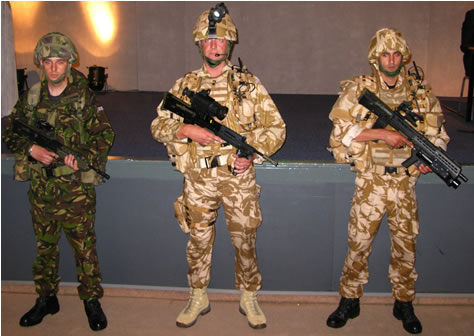Britain’s FIST program encountered some delays last year, as the Ministry of Defence (MOD) addressed urgent operational requirement (UOR) from deployed Army units, to improve communications and situational awareness at infantry squad and platoon level, engaged in combat operations in Afghanistan. Colonel Peter Rafferty MBE, Individual Capability Group Leader FIST, briefed on some of the UORs currently underway. As FIST systems are still immature for operational use, the program office utilizes some elements used in the evaluation process, although they were not considered for the program itself. Therefore, Rafferty cautions, the devices currently being operated in Afghanistan are not representative of full FIST quality and cannot therefore be regarded as ‘spin-off’ from the future program, but only as stop-gap applications, improving existing equipment.

 The systems being delivered as part of the program, include an improved version of the Selex personal role radio (PRR). As part of the Enhanced Low-Latency Situational Awareness (ELSA) UOR program, the new radios provide encrypted voice and data transfer capability. For situational awareness and force tracking, leaders are equipped with the Miltrak system produced by Thales. This cellphone-size unit indicates the relative location of each team member, presented on a digital map. Automatic warning can be issued for team members that have not reported their last location. In addition, enhancements are provided to squads and platoons, as part of the Integrated Sights and Target Acquisition system (SISTA). This upgrade includes the delivery of optical (ACOG) weapon sights, thermal binoculars, and laser rangefinder. With the delivery of SISTA, combat units received more thermal imaging systems, since these devices are performing better under the starless dark nights in the Afghan mountains and desert, where light ‘pollution’ is almost non existent. British forces have reported, that most nights in Afghanistan, particularly those in the isolated mountain ranges of Helmand, are too dark for I2 to operate effectively, therefore requiring the operation of thermal imaging equipment.
The systems being delivered as part of the program, include an improved version of the Selex personal role radio (PRR). As part of the Enhanced Low-Latency Situational Awareness (ELSA) UOR program, the new radios provide encrypted voice and data transfer capability. For situational awareness and force tracking, leaders are equipped with the Miltrak system produced by Thales. This cellphone-size unit indicates the relative location of each team member, presented on a digital map. Automatic warning can be issued for team members that have not reported their last location. In addition, enhancements are provided to squads and platoons, as part of the Integrated Sights and Target Acquisition system (SISTA). This upgrade includes the delivery of optical (ACOG) weapon sights, thermal binoculars, and laser rangefinder. With the delivery of SISTA, combat units received more thermal imaging systems, since these devices are performing better under the starless dark nights in the Afghan mountains and desert, where light ‘pollution’ is almost non existent. British forces have reported, that most nights in Afghanistan, particularly those in the isolated mountain ranges of Helmand, are too dark for I2 to operate effectively, therefore requiring the operation of thermal imaging equipment.
FIST is being integrated into Britain’s future weapon systems programs under the Integrated Soldier System Strategy (IS3). Over the past two years, the program went through the FIST assessment phase, under which, different systems were tested and evaluated, matching expectations for performance and services with currently available technology. Some of the lessons learned from these tests were already implemented. As FIST enters it’s next phase, procurement will continue in three increments, each to include an assessment, development, testing and deployment phase.
FIST systems will not be limited to the warfighters alone, but extend (in a basic configuration) to combat support and service- support elements, which must be networked and connected into the system, to be included in the overall situational picture, effectively link to combat formations and eliminate the risk of fratricide (in an all-connected combat environment, a non-networked element becomes a critical liability and the weakest point, most susceptible to fratricide).
Defense Update report from Soldier Technology 2008 is focusing on these topics:
-
FIST Derivatives Rush to Afghanistan to Support British Army Troops

















